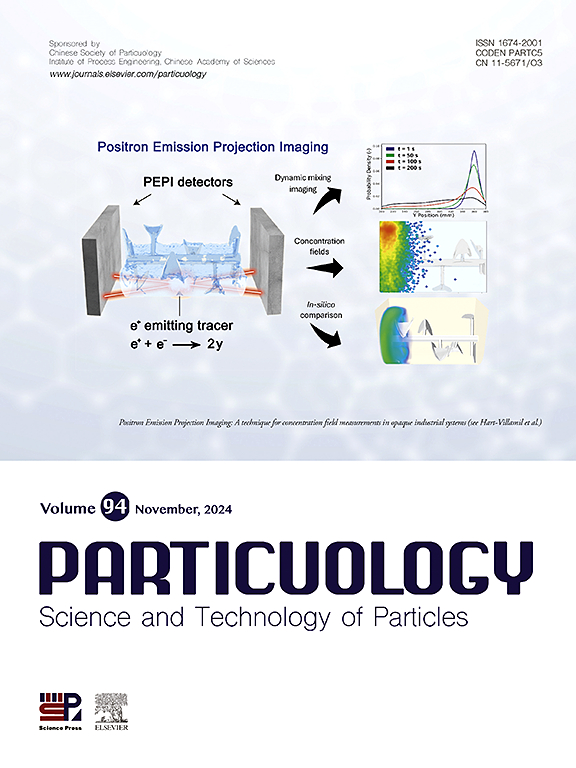沙粒对沙漠环境风沙两相流运动和输运特性的影响
IF 4.3
2区 材料科学
Q2 ENGINEERING, CHEMICAL
引用次数: 0
摘要
沙粒对风沙两相流运动和输运特性的影响是解决全球沙漠化问题的重要理论基础。采用TFM方法详细研究了风沙两相流中沙粒大小对气流特性、沙粒运动特性和输运分布的影响。结果表明,沙粒的存在降低了气流速度,扩大了气流动态范围,加剧了动量传递过程。当砂粒度从10 μm增加到400 μm时,动态高度和最大湍流动能分别降低79.3%和82.1%。水平方向和垂直方向的初始跃迁速度主要分布在−0.1 ~ 0.7 m/s和0 ~ 0.6 m/s范围内。峰值比例对应的水平和垂直初始跃变速度随砂粒大小的减小而增大。输沙通量的水平和垂直分布符合指数递减规律,反映了输沙进入沙漠流场的大小、分布和程度。当沙粒直径从100 μm增加到400 μm时,垂直和水平方向输沙通量最大值分别增加了1.83倍和1.01倍,输沙指数分别下降了5.6%和10.3%。随着沙粒增大,低、高空气摩擦速度下输沙范围的变化特征不同。这些研究成果为荒漠化治理提供了重要的理论指导。本文章由计算机程序翻译,如有差异,请以英文原文为准。

Influence of sand size on motion and transport characteristics of wind-sand two-phase flow in desert environments
The influence of sand size on motion and transport characteristics of wind-sand two-phase flow is a crucial theoretical foundation for addressing global desertification issues. This study conducts a detailed investigation into the influence of sand size on air flow characteristics, sand motion behaviors, and transport distributions in the wind-sand two-phase flow using TFM method. The results indicate that the existence of sand particles decreases the air velocity, widens the air dynamic range and intensifies the momentum transfer process. When the sand size increases from 10 to 400 μm, the dynamic height and maximum turbulent kinetic energy decrease by 79.3 % and 82.1 %, respectively. The initial saltation velocities in the horizontal and vertical directions are predominantly distributed within the ranges of −0.1 to 0.7 m/s and 0–0.6 m/s, respectively. The initial horizontal and vertical saltation velocities corresponding to the peak proportion increase with decreasing sand size. The horizontal and vertical distributions of sediment transport flux conform to the exponential decline law, reflecting the magnitude, distribution and extent of sand transportation into the desert flow field. When the sand diameter rises from 100 to 400 μm, the maximum values of sediment transport flux in vertical and horizontal directions increase by 1.83 times and 1.01 times, respectively, while the transport indexes decrease by 5.6 % and 10.3 %, respectively. The variation characteristics of sediment transport range differ between low and high air friction velocities as sand size increases. These research findings provide important theoretical guidance for the control of desertification.
求助全文
通过发布文献求助,成功后即可免费获取论文全文。
去求助
来源期刊

Particuology
工程技术-材料科学:综合
CiteScore
6.70
自引率
2.90%
发文量
1730
审稿时长
32 days
期刊介绍:
The word ‘particuology’ was coined to parallel the discipline for the science and technology of particles.
Particuology is an interdisciplinary journal that publishes frontier research articles and critical reviews on the discovery, formulation and engineering of particulate materials, processes and systems. It especially welcomes contributions utilising advanced theoretical, modelling and measurement methods to enable the discovery and creation of new particulate materials, and the manufacturing of functional particulate-based products, such as sensors.
Papers are handled by Thematic Editors who oversee contributions from specific subject fields. These fields are classified into: Particle Synthesis and Modification; Particle Characterization and Measurement; Granular Systems and Bulk Solids Technology; Fluidization and Particle-Fluid Systems; Aerosols; and Applications of Particle Technology.
Key topics concerning the creation and processing of particulates include:
-Modelling and simulation of particle formation, collective behaviour of particles and systems for particle production over a broad spectrum of length scales
-Mining of experimental data for particle synthesis and surface properties to facilitate the creation of new materials and processes
-Particle design and preparation including controlled response and sensing functionalities in formation, delivery systems and biological systems, etc.
-Experimental and computational methods for visualization and analysis of particulate system.
These topics are broadly relevant to the production of materials, pharmaceuticals and food, and to the conversion of energy resources to fuels and protection of the environment.
 求助内容:
求助内容: 应助结果提醒方式:
应助结果提醒方式:


